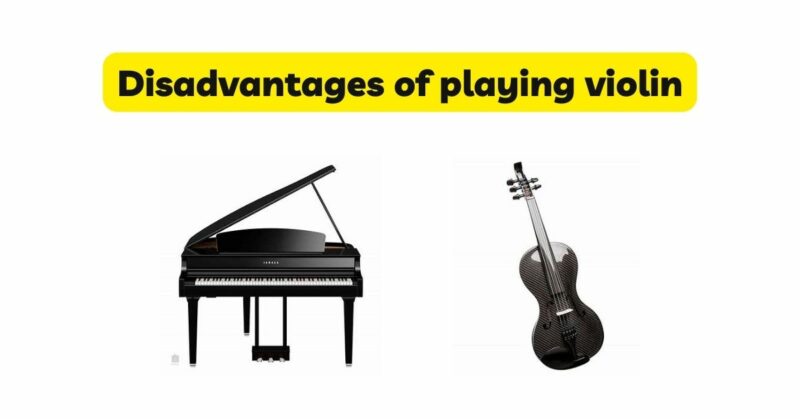The violin is a beautiful and captivating instrument that has mesmerized audiences for centuries. While it offers numerous rewards and opportunities for artistic expression, it is important to acknowledge that playing the violin also presents certain challenges and disadvantages. In this article, we will delve into the potential drawbacks of playing the violin, including physical demands, technical complexities, intonation challenges, and the dedication required for mastery. By understanding these disadvantages, aspiring violinists can approach their musical journey with realistic expectations and the determination necessary to overcome these obstacles.
- Physical Demands and Potential Discomfort: Playing the violin places unique physical demands on the body. The instrument must be supported by the chin, shoulder, and collarbone, requiring proper posture and positioning. This can lead to discomfort and strain, especially for beginners who have not yet developed the necessary muscle strength and stamina. Holding the violin for extended periods of time can cause fatigue and even potential injuries if proper technique and ergonomics are not maintained. Additionally, the repetitive motion of bowing can put strain on the wrist, forearm, and shoulder joints. Proper warm-up exercises, stretching, and regular breaks are essential to minimize the risk of physical discomfort and injury.
- Technical Complexity and Steep Learning Curve: The violin is renowned for its technical complexity, which contributes to its reputation as one of the most challenging instruments to learn. From the precise finger placement on the fingerboard to the intricate bowing techniques, mastering the technical aspects of the violin requires dedicated practice and perseverance. Beginners often face difficulties in producing a clear and resonant sound due to the absence of frets or keys that provide visual cues for intonation. The process of training the ear to distinguish and correct intonation is a continuous journey that demands time and patience. The learning curve can be steep, and progress may seem slow in the initial stages. However, with consistent practice and guidance from a qualified teacher, these technical challenges can be overcome.
- Intonation and Pitch Control: Intonation, the accuracy of pitch, is a critical aspect of violin playing. Unlike instruments with fixed pitches, such as the piano, the violin requires players to rely on their ears to produce and adjust pitches. The absence of frets or keys means that intonation must be achieved through muscle memory and ear training. This process requires a keen sense of pitch and the ability to make precise adjustments with the fingers. Achieving and maintaining accurate intonation across different positions and complex musical passages can be a significant challenge for violinists. Developing a highly refined sense of pitch and consistent intonation requires extensive practice, patience, and a deep understanding of musical intervals.
- Bowing Techniques and Bow Control: The bowing techniques employed on the violin are vital for producing a variety of expressive sounds and dynamics. However, mastering bow control is a demanding aspect of violin playing. Achieving a smooth and controlled bowing motion, while maintaining consistent pressure and speed, requires significant coordination and practice. Different bowing techniques, such as legato, staccato, spiccato, and martelé, add further layers of complexity. Developing a refined bowing technique involves training the muscles to produce a consistent and resonant sound across different parts of the bow and adjusting the bow angle and contact point on the strings. It requires patience, attention to detail, and a keen ear to achieve the desired tone and expression.
- Time and Dedication: Mastery of the violin requires a significant investment of time and dedication. Progress on the instrument is directly proportional to the amount of practice and consistent effort put in. Building the technical skills, developing a rich and expressive sound, and acquiring a diverse repertoire demand regular and focused practice sessions. Balancing the demands of daily practice with other commitments can be challenging, especially for students or individuals with busy schedules. The journey of learning the violin often requires patience and persistence, as progress may not be immediate or linear. However, with a disciplined approach and a commitment to regular practice, the rewards of improvement and artistic growth become evident.
- Instrument Cost and Maintenance: Another potential disadvantage of playing the violin is the cost associated with acquiring and maintaining a quality instrument. Violins can vary significantly in price, with higher-quality instruments often commanding a substantial investment. For beginners or individuals on a limited budget, finding an affordable instrument that still offers decent sound quality can be a challenge. Additionally, maintaining the instrument’s condition requires periodic maintenance, including restringing, adjustments, and repairs. These costs should be considered when embarking on the violin journey.
Conclusion: While the violin presents certain challenges and disadvantages, they should not overshadow the immense joy and artistic fulfillment that can be achieved through playing this remarkable instrument. Acknowledging and understanding the potential drawbacks, such as physical demands, technical complexities, intonation challenges, time commitment, and instrument cost, enables aspiring violinists to approach their musical journey with realistic expectations. With dedication, perseverance, and the guidance of a skilled teacher, these challenges can be overcome. The violin offers a world of musical expression and a lifelong journey of growth and discovery for those who embrace its unique demands. Embrace the challenges, stay committed, and allow the captivating sound of the violin to be your guide on a remarkable musical adventure.


